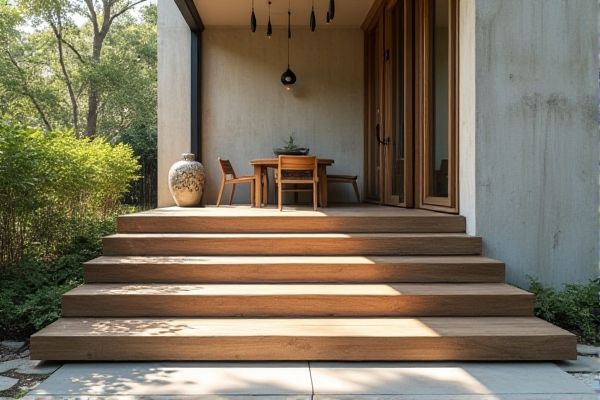
Concrete steps offer superior durability and low maintenance, making them ideal for high-traffic areas and harsh weather conditions. If you're weighing options for your next project, explore the full comparison to determine which material best suits your needs.
Table of Comparison
| Feature | Concrete Steps | Wood Steps |
|---|---|---|
| Durability | Highly durable, withstands weather and heavy use | Less durable, susceptible to rot, pests, and weather damage |
| Maintenance | Low maintenance, occasional cleaning and sealing | High maintenance, requires regular sealing and repairs |
| Cost | Higher initial cost, low long-term cost | Lower initial cost, higher maintenance cost over time |
| Installation | Requires professional installation, time-consuming | Easier DIY installation, faster to install |
| Aesthetic | Modern, solid look; limited design options | Natural, warm appearance; flexible design options |
| Slip Resistance | Can be slippery when wet unless textured | Generally better grip, safer when wet |
| Lifespan | 50+ years with proper care | 10-30 years depending on wood type and maintenance |
Introduction to Concrete Steps vs Wood Steps
Concrete steps offer superior durability and require minimal maintenance compared to wood steps, which are prone to rot, insect damage, and weathering over time. While wood steps provide a warm, natural aesthetic and are easier to install or modify, concrete steps deliver enhanced strength and longevity suited for heavy foot traffic and diverse climates. Choosing between concrete and wood steps depends on factors such as budget, desired appearance, and long-term maintenance commitments.
Durability Comparison: Concrete vs Wood
Concrete steps offer superior durability compared to wood steps, as they are highly resistant to weathering, rot, and insect damage. Wood steps require regular maintenance, such as sealing and staining, to prevent decay and extend their lifespan. Concrete typically lasts 30-50 years or more with minimal upkeep, while wood steps often need replacement or significant repair within 10-15 years.
Cost Analysis: Upfront and Long-Term Expenses
Concrete steps typically have higher upfront costs due to materials and labor but offer long-term durability with minimal maintenance expenses. Wood steps often lower initial investment costs but may incur increased maintenance and replacement fees over time due to susceptibility to rot, insects, and weathering. Evaluating Your budget should include both initial outlays and projected upkeep to determine the most cost-effective option.
Installation Process Differences
Concrete steps require a more labor-intensive installation process involving excavation, forming, and curing, which can take several days to complete. Wood steps are generally quicker to install due to prefabricated components that can be assembled on-site with basic tools. Your choice affects project duration and labor costs depending on the complexity of each material's installation requirements.
Maintenance Requirements for Each Material
Concrete steps demand minimal maintenance, requiring only occasional sealing and crack repairs to prevent water damage and deterioration. Wood steps need regular upkeep, including cleaning, sanding, staining, or painting to protect against rot, insects, and weathering. Your choice depends on how much time and effort you're willing to invest in preserving the appearance and durability of your steps.
Aesthetic Options: Styles and Finishes
Concrete steps offer versatile aesthetic options with customizable textures, colors, and finishes such as stamped patterns, exposed aggregate, or smooth troweled surfaces that mimic natural stone or brick. Wood steps provide a warm and classic look with a variety of stain and paint choices, allowing you to highlight natural grain patterns or achieve bold color accents. Your choice depends on desired durability and style, with concrete excelling in low-maintenance finishes and wood lending itself to traditional or rustic designs.
Safety Considerations and Slip Resistance
Concrete steps offer superior durability and enhanced slip resistance due to their textured surfaces and ability to incorporate anti-slip additives, making them a safer choice in wet or icy conditions. Wood steps, while aesthetically pleasing, require regular maintenance such as sealing and adding non-slip strips to maintain adequate safety and prevent rot or warping that could increase slip hazards. Your choice should weigh these safety factors carefully, prioritizing materials that reduce the risk of falls and provide reliable traction under various weather conditions.
Environmental Impact and Sustainability
Concrete steps have a higher carbon footprint due to cement production, which releases significant CO2 emissions, whereas wood steps are renewable and biodegradable when sourced from sustainably managed forests. Wood steps can contribute to carbon sequestration during the tree growth phase, but their durability may be lower, potentially requiring more frequent replacement. Choosing FSC-certified wood or recycled concrete can improve sustainability in construction projects, minimizing environmental impact.
Weather Resistance and Lifespan
Concrete steps exhibit superior weather resistance compared to wood, as they are impervious to moisture, rot, and insect damage, making them ideal for harsh climates. Their lifespan typically exceeds 50 years with minimal maintenance, while wood steps often require regular sealing and treatment to prevent decay and usually last 10-20 years depending on exposure. Concrete's durability ensures long-term stability and safety, especially in regions with extreme temperature fluctuations and heavy rainfall.
Choosing the Right Steps for Your Property
Concrete steps offer superior durability and low maintenance, making them ideal for properties exposed to heavy foot traffic or harsh weather conditions. Wood steps provide a natural aesthetic and versatility in design, but require regular sealing and inspection to prevent rot and insect damage. Selecting the right steps depends on balancing long-term cost, climate resilience, and the desired architectural style of your property.
 homyna.com
homyna.com